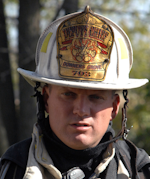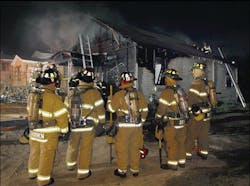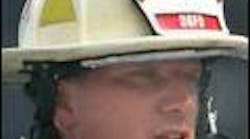Fireground Assessment for Rapid Intervention Teams
The assignment to the rapid intervention function prior to on scene arrival is an aspect that should be considered when drafting policies and procedures for fire departments. This makes certain that the role is not overlooked and properly prepares the crew of firefighters responding.
The rapid intervention team (RIT) size up begins while enroute to the incident. While responding, the radio channels being utilized need to be intently monitored. What picture is being painted of the fireground? Are companies performing high risk activities to facilitate rescue, such as vent-enter-search? What type of building construction is given in the size-up and what kind of lead out is being deployed? Information such as this will tell a lot in relation to what could be expected if a RIT is put into action.
Face-to-Face Meeting
Once arriving on scene, the RIT or its leader will need to report to the command post and obtain a quick briefing of the incident. Important information that must be obtained includes:
- Which companies are operating and where?
- How long have they been operating?
- How much progress have they made?
- What type of accountability system is in place?
By no means should a RIT take the incident commander's focus away from the incident for a lengthy dissertation of what is taking place -- most of the information needed can be easily obtained from a well-designed and properly filled out tactical worksheet. A quick glance and short verbal exchange of some important points is all that it should take before the RIT member is on their way. Some additional information that should be ascertained before leaving the command post includes the staging location for the RIT (if already established), the radio channel assignment that fireground operations are on and confirmation of what radio channel that is available in the event of a Mayday. A pre-plan drawing of the building should also be obtained for reference at this time if one is available.
While the RIT assembles its equipment at an advantageous point, the RIT leader should make certain to get a good look at all sides of the structure that crews are operating in. Some important issues that must be addressed in the RIT size-up:
- What is the status of the fire -- where has it been, where is it at and where can we expect to see it progress?
- Can the presenting smoke conditions give you any of those answers to the above questions and are companies operating inside aware of what is being seen outside?
- Are the tactics being utilized coincide with the conditions that you are seeing?
- What type of building construction is present in all parts of the building and is there anything unique about the building' construction that can cause problems?
Proactive Vs. Reactive
What proactive behaviors can be taken on the exterior by the RIT to ease conditions or aide operating firefighters if they need to egress from their position immediately? We are not talking about tasks that involve physically demanding or extensive operations, but rather tasks that that can be accomplished quickly without the RIT expending much energy and keeping them from being available at a moments notice to be deployed to help a firefighter in trouble. Forcing a door, removing glass, dismantling security bars, throwing ladders to upper levels and controlling utilities are all tasks that should be able to be accomplished without much effort. If they will require much effort because of special circumstances, than it is time inform the incident vommander to get companies dedicated to these tasks to make certain that they get accomplished.
Available Resources
What resources are available for the RIT's use if needed? It is true that the RIT needs to be self-sufficient, but that may not be possible in every circumstance presented. Does the closest engine have the capability of providing additional lines for the RIT -- depending on department policy; it may be wise to have the RIT secure that line for its use as soon as the RIT is established in their position. Does the engine have any ladders or other equipment that can be utilized if needed? How about the truck closest to the incident -- do the members of the RIT understand how to operate the aerial if needed? What tools and how many ladders are available on that rig if needed?
Where is EMS set up as well as rehab? If set into motion, this information will become very important to RIT members. Where are they taking firefighters for treatment once removed from the building as well as care for their team? The RIT should establish communications as well as a plan of action with these important functions.
When it comes to the rescue of one of our own, we must be ready to do what is necessary to ensure success and the safety of the members that we commit to action. Is your department ready to meet that challenge?
JEFFREY PINDELSKI, a Firehouse.com Contributing Editor, is a 20-year veteran and student of the fire service and is the deputy chief of operations with the Downers Grove, IL, Fire Department. Jeff is a staff instructor at the College of Du Page and has been involved with the design of several training programs dedicated to firefighter safety and survival. Jeff is the co-author of the text R.I.C.O., Rapid Intervention Company Operations. Jeff was host of the recentPreparing for Tomorrow's RIT Deployment Today podcast was a guest on the inaugural edition of the Training & Tactics Talk. View all of Jeff's articles and podcasts here. You can reach Jeff by e-mail at [email protected].

Jeffrey Pindelski
JEFFREY PINDELSKI is the Downers Grove, IL, Fire Department Chief (Ret.) and has been a student of the fire service for more than 30 years. He served as a chief officer for more than 15 years of his career, during which time he directly managed every aspect of the fire department at one time or another. Pindelski holds a master's degree in Public Safety Administration from Lewis University and earned a Graduate Certificate in Managerial Leadership and a bachelor's degree from Western Illinois University. He is the co-author of "R.I.C.O.- Rapid Intervention Company Operations" and was a revising author of the third edition of "Firefighter's Handbook." Pindelski presented at numerous fire service conferences and had more than 55 articles published in trade journals on various fire service-related topics. He is a recipient of Illinois' Firefighting Medal of Valor.







